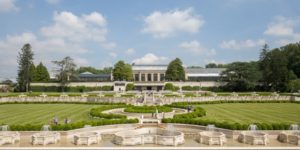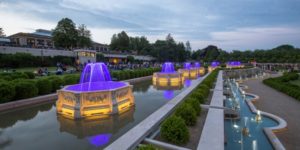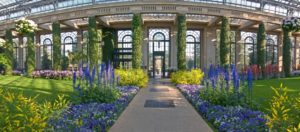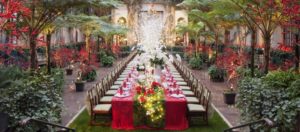Longwood Gardens is a botanical garden in Kennett Square, Pennsylvania. It comprises over 1,077 acres (436 hectares; 4.36 km²) of gardens, woodlands, and meadows in the Brandywine Creek Valley.
It’s long been considered one of the premier horticultural display gardens in the United States, and is open to visitors year-round to enjoy exotic plants and horticulture (indoor and outdoor), events and performances, seasonal and themed attractions, as well as educational lectures, courses, and workshops.
 In late May of 2017, a splashy fanfare heralded the first stage of a major renovation of the historic gardens. Even a rainy night couldn’t dampen the effect of the Main Fountain Garden’s jet spray (1,340 new jets, 379 “legacy” ones) that shot up into the sky as high as 175 feet—the height of a 15-story building.
In late May of 2017, a splashy fanfare heralded the first stage of a major renovation of the historic gardens. Even a rainy night couldn’t dampen the effect of the Main Fountain Garden’s jet spray (1,340 new jets, 379 “legacy” ones) that shot up into the sky as high as 175 feet—the height of a 15-story building.
The shimmering spectacle was dramatized by a multicolor array of LED lighting, and enhanced by an eye-popping display of fireworks. It all may sound ephemeral, but the event represented an impressive collaboration between New York architects Beyer Blinder Belle (BBB); the Dutch urban planning and landscape design firm West 8; a Los Angeles–based water feature consultant, Fluidity Design; and New York lighting specialists L’Observatoire and the interdisciplinary group Pentagram.
 The event marked ongoing major plans for Longwood. “This is only the beginning,” says Paul Redman, president and CEO of the gardens. Today, du Pont’s accomplishment is organized around three connected Beaux-Arts-style conservatories, and attracts an estimated 1.35 million visitors a year to this verdant territory near Wilmington, Delaware.
The event marked ongoing major plans for Longwood. “This is only the beginning,” says Paul Redman, president and CEO of the gardens. Today, du Pont’s accomplishment is organized around three connected Beaux-Arts-style conservatories, and attracts an estimated 1.35 million visitors a year to this verdant territory near Wilmington, Delaware.
The reopening of this largest fountain after a 2½-year reconstruction is tied to a 40-year renovation master plan that Redman initiated in 2009, with an invited competition won by West 8. The firm’s plan, completed in 2011, doesn’t, according to principal Claire Agre, “just deal with horticulture and upgrading infrastructure and facilities, but addresses the guest experience and strategies for arrival, as well as how the entire acreage can be opened up for the public.”
 For the renovation of the Main Fountain Garden, BBB, responsible for the restoration of Grand Central Terminal and the Enid A. Haupt Conservatory at the New York Botanical Garden, led the team. For starters, the fountains needed major work, which, with improved technology, would cost $90 million, paid privately through the Longwood Foundation and its younger offshoot, Longwood Gardens, Inc.
For the renovation of the Main Fountain Garden, BBB, responsible for the restoration of Grand Central Terminal and the Enid A. Haupt Conservatory at the New York Botanical Garden, led the team. For starters, the fountains needed major work, which, with improved technology, would cost $90 million, paid privately through the Longwood Foundation and its younger offshoot, Longwood Gardens, Inc.
“New Heights: The Fountain Revitalization Project” replaces the 83-year-old fountains’ infrastructure with the latest technology, improves guest access to the Garden, and adds innovative new elements that honor Pierre S. du Pont.
 West 8 is responsible for the design of the garden’s public spaces to harmonize with the original design, the enhancement of the Main Fountain Garden’s horticultural elements and the creation of new gardens that will provide new amenities for Longwood’s guests. The new public spaces will achieve a renaissance for the Garden while retaining its identity as recognizably “Longwood.”
West 8 is responsible for the design of the garden’s public spaces to harmonize with the original design, the enhancement of the Main Fountain Garden’s horticultural elements and the creation of new gardens that will provide new amenities for Longwood’s guests. The new public spaces will achieve a renaissance for the Garden while retaining its identity as recognizably “Longwood.”
Within the context of the master plan, which aims to transform Longwood Gardens into one of the Great Gardens of the World, the Main Fountain Garden becomes the first and most dramatic encounter in the 1,077 acres of gardens at Longwood.
Creating a new model for how interdisciplinary projects such as these unfold, the revitalization by Beyer Blinder Belle + West 8 + Fluidity includes:
- the complete restoration of 4,000 pieces of carved Italian limestone by specialists throughout the five-acre Garden;
- the total replacement of the fountains’ electric and plumbing infrastructure with 21st-century systems that pump 300,000 gallons of water around 380 fountains, allowing the fountains to run more efficiently and for a significantly longer period of time during the year;
- new water choreography, which will include jets that project water 175 feet in the air—45 feet higher than the current capabilities; the jets will also allow for more precise control of the water movement to create unique undulating, flexing, spinning effects, and a state of the art flame feature;
- replacement of the fountain lighting system with energy-efficient LED lights, which will also allow the water choreography to take on a new range of colors;
- new areas for guests to explore, honoring the spirit of the original design, including:
- the re-opening of the elegant south wall, which has been closed to the public for the last 20 years, containing 20 wall-mounted fountains;
- the Grotto, entered from passageways on either side of the loggia, which lead to a vaulted central hall; at the center will be a circular water curtain wall and oculus that allows natural light to enter the space;
- a trellis bridge connecting to the Fountain Terrace allowing guests to look out over the surrounding gardens;
- new seating areas, including a seat wall along the fountains as well as table and chairs behind the trellis bridge;
- a renovated Pump House lobby, which will showcase the original pumps that powered the Main Fountain Garden from 1931 to 2014;
- an enhanced landscape that includes increased planting, enhanced horticultural displays, and expanded, fully accessible walking areas.
Longwood Gardens has a long and varied history, as do the grounds on which it lies. For thousands of years, the native Lenni Lenape tribe fished its streams, hunted its forests, and planted its fields. Evidence of the tribe’s existence is found in quartz spear points that have been discovered on and around the property and can be found on display in the Peirce-du Pont House on the Longwood Gardens property.
 In 1700, a Quaker farmer named George Peirce purchased 402 acres of this English-claimed land from William Penn’s commissioners. George’s son Joshua cleared and farmed the land and in 1730 he built the brick farmhouse that, enlarged, still stands today.
In 1700, a Quaker farmer named George Peirce purchased 402 acres of this English-claimed land from William Penn’s commissioners. George’s son Joshua cleared and farmed the land and in 1730 he built the brick farmhouse that, enlarged, still stands today.
In 1798, Joshua’s twin grandsons Samuel and Joshua, who had inherited the farm, actively pursued an interest in natural history and began planting an arboretum that eventually covered 15 acres. The collection included specimens that they collected from the wild as well as plants acquired from some of the region’s leading botanists.
By 1850, the arboretum boasted one of the finest collections of trees in the nation, and had become a place for the locals to gather outdoors – a new concept that was sweeping America at the time. Community picnics and socials were held at Peirce’s Park in the mid to late 19th century.
At the start of the 20th century, the family’s heirs lost interest in the property and allowed the arboretum to deteriorate. The farm passed out of the family through several hands in quick succession, and a lumber mill operator was about to cut down the trees for timber in early 1906.
This threat moved Pierre S. du Pont, the entrepreneur, businessman, philanthropist, and member of the prominent du Pont family to take action.
On July 20, 1906, 36-year-old du Pont purchased the farm, primarily to preserve the trees. He wasn’t planning to create Longwood Gardens, but within a few years, his desire to make it a place where he could entertain his friends transformed a simple country farm into one of the country’s leading horticultural display gardens.
When Pierre du Pont died in 1954, he had put in place a well-funded, adaptable mechanism for the long-term preservation of Longwood Gardens.
All photos courtesy of West 8 unless otherwise credited.
Featured photo at top courtesy of Longwood Gardens.
See Architectural Record article by Suzanne Stephens.


